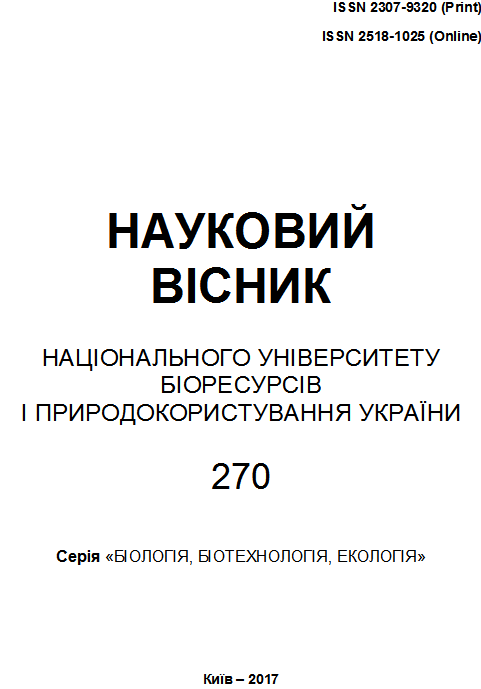SEGMENTAL PLANTS OF PLANTATIONS OF TOMATOES AS RESERVOIRS OF PHYTOPATHOGENIC BACTERIA
Abstract
In Ukraine, weeds as an ecological niche of phytopathogenic bacteria have been studied fragmentarily. Our aim was to investigate the spread of tomato P. syringae pv on weeds in plantations tomato, widely known in Ukraine the causative agent of bacterial speck, and X. vesicatoria - the causative agent of bacterial black spotting. The studies were carried out using standard microbiological methods, the virulent properties of isolated isolates were studied by the method of artificial infection. From samples of healthy segetal plants that are selected in plantations of tomatoes, we isolated and identified phytopathogenic bacteria Xanthomonas sp., Pseudomonas syringae, Pseudomonas sp., Pseudomonas viridiflava and Pantoea agglomerans. Isolated bacterial under conditions of artificial contamination of vegetable cultures caused typical symptoms of bacterial diseases. It was established that outwardly healthy weeds in plantations of tomatoes are accumulators of highly aggressive strains of bacteria of the genus Pseudomonas and Xanthomonas.
References
Patyka, V. F. & Yakovleva, L. M. (2011) Bakteriozy i sornyaki: ushcherb i novye shansy [Bacteriosis and weeds: damage and new chances] Zerno [Corn] 1, 27–28. [in Russian].
Khusnetdinova, K. A. (2017) Struktura soobshchestv epifitnykh bakterіy kul’turnikh i sornykh rasteniy [The structure of communities of epiphytic bacteria of cultural and weed plants] (Candidate of Biological Sciences Dissertation). Moscow, Russia. [in Russian].
Hvozdiak, R. I. & Lukach, M. I. (2001) Epifitna faza Erwinia amylovora i R. syringae pv. syringae na burianakh plodovykh sadiv [Epiphytic phase of Erwinia amylovora and P. syringae pv. Syringae on weeds of orchards] Mikrobiolohichnyi zhurnal [Microbiological Journal] 63 (3), 43–50. [in Ukrainian].
Gvozdyak, R. I., Yakovleva, L. M., Shcherbina, T. N., Ogorodnik, L. E. & Barbakar A.V. (2005) Sornye rasteniya kak ekologicheskaya nisha fitopatogennykh bakteriy [Weeds as an ecological niche of phytopathogenic bacteria] Mizhnarodna naukova konferentsiia «Fitopatohenni bakterii. Fitontsydylohiia. Alelopatiia» [International Scientific Conference «Phytopathogenic bacteria. Phytoncidilogy. Allelopathy»]. (pp. 55–59). October 4–6, 2015, Kyiv, Ukraine. [in Russian].
Gvozdyak, R. I., Yakovleva, L. M., Pasichnik, L. A., Shcherbina, T. N. & Ogorodnik L. E. (2005) Bakterii roda Pseudomonas na sornyakakh [Bacteria of the genus Pseudomonas on weeds] Mikrobiolohichnyi zhurnal [Microbiological Journal] 67 (2), 63–69. [in Russian].
Fernández-Sanz, A.M., Rodicio, M.R. & González A.J. (2016) Pseudomonas syringae pv. phaseolicola isolated from weeds in bean crop fields. Lett Appl Microbiol. Vol. 62(4). P. 344–348. [in English].
Ignatov, A., Sechler, A., Schuenzel, E.L., & Agarkova I. (2007) Genetic diversity in populations of Xanthomonas campestris pv. campestris in cruciferous weeds in Central Coastal California. Phytopathology. Vol. 97(7). P. 803–812. [in English].
Savenko, O. A., Pasichnyk, L. A. & Patyka V. P. (2015) Zbudnyky khvorob sehetalnoi roslynnosti v ahrotsenozi pshenytsi [Pathogens of diseases of segetal vegetation in agrocenoses of wheat] Naukovi zapysky Ternopilskoho nats. ped. un-tu. Seriia Bioliia. [Scientific notes of the Ternopil national Ped. University. Series Biolium.] 1 (62), 124–132. [in Ukrainian].
Zakharenko, A.V. (2000) Teoreticheskie osnovy upravleniya sornym komponentom agrofitotsenoza v sistemakh zemledeliya [The theoretical basis for the management of the weed component of agrophytocenosis in farming systems]. Moscow, МSHА. [in Russian].
Patyka, V. P. (Ed) (2014) Diahnostyka fitopatohennykh bakterii [Diagnostics of phytopathogenic bacteria] Kyiv [in Ukrainian].
Klement, Z., Rudolph, K. & Sands, D. S. (1990) Methods in phytobacteriology. Budapest: Akademia kiado. [in English].
Kolomiiets, Yu. V., Hryhoriuk, I. P. & Butsenko, L. M. (2017) Bakterialni khvoroby sehetalnykh roslyn v nasadzhenniakh tomativ [Bacterial diseases of segetal plants in plantations of tomatoes] Karantyn i zakhyst roslyn [Quarantine and plant protection] 4–6, 10–14. [in Ukrainian].
Boore, D.R., Castenholz, R.W. & G.M. Garrity (2005) Bergey’s manual of systematic bacteriology. Vol. 1, 2nd ed., New York, Berlin, Heidelberg: Springer. [in English].
Zheldakova, R. A. & Myamin, V. E. (2006) Fitopatogennye mikroorganizmy [Phytopathogenic microorganisms] Minsk: BGU. [in Russian].
Yakovleva, L. M., Gvozdyak, R. I., Patyka, V. P. & Shcherbina, T. N. (2009) Fitopatogennye bakterii pyreya polzuchego v posevakh pshenitsy [Phytopathogenic bacteria of wheatgrass creeping in wheat crops] Mikrobiolohichnyi zhurnal [Microbiological Journal] 71 (3), 30–37. [in Russian].
Pasichnyk, L.A., Butsenko, L.M. & Dvorak, K.P. (2013).
Пасічник Л.А. Biolohichni osoblyvosti Pseudomonas viridiflava, izolovanykh iz nasinnia tsukrovykh buriakiv [Biological features of Pseudomonas viridiflava isolated from sugar beet seeds] Naukovyi visnyk Natsionalnoho universytetu bioresursiv i pryrodokorystuvannia Ukrainy. Seriia: «Biolohiia, biotekhnolohiia, ekolohiia» [Scientific Bulletin of the National University of Life and Environmental Sciences of Ukraine. Series «Biology, biotechnology, ecology».] 193, 26–31. [in Ukrainian].
Downloads
Published
Issue
Section
License
Relationship between right holders and users shall be governed by the terms of the license Creative Commons Attribution – non-commercial – Distribution On Same Conditions 4.0 international (CC BY-NC-SA 4.0):https://creativecommons.org/licenses/by-nc-sa/4.0/deed.uk
Authors who publish with this journal agree to the following terms:
- Authors retain copyright and grant the journal right of first publication with the work simultaneously licensed under a Creative Commons Attribution License that allows others to share the work with an acknowledgement of the work's authorship and initial publication in this journal.
- Authors are able to enter into separate, additional contractual arrangements for the non-exclusive distribution of the journal's published version of the work (e.g., post it to an institutional repository or publish it in a book), with an acknowledgement of its initial publication in this journal.
- Authors are permitted and encouraged to post their work online (e.g., in institutional repositories or on their website) prior to and during the submission process, as it can lead to productive exchanges, as well as earlier and greater citation of published work (See The Effect of Open Access).

